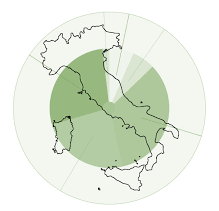In 2016, the World Health Assembly adopted the resolution to eliminate viral hepatitis by 2030. A GBD study led by the University of Milan-Bicocca, published in the journal The Lancet Public Health, aimed to provide an overview of the impact of hepatitis B virus (HBV) and hepatitis C virus (HCV) in Europe and their changes from 2010 to 2019 using estimates from the Global Burden of Diseases, Injuries, and Risk Factors Study (GBD) 2019 and highlighted what strategies to put in place to move toward this elimination.
The study, coordinated by CESP (Centro Ricerca Sanità Pubblica) at Bicocca di Milano and IHME (Institute for Health Metrics and Evaluation) at the University of Washington – Seattle, WA, USA, tracks for the first time in Europe incidence, prevalence, mortality and disability-adjusted life years lost (DALYs) of hepatitis B and C virus-related diseases from 2010 to 2019 (Hepatitis B and C in Europe: an update from the Global Burden of Disease Study 2019 – The Lancet Public Health)
Hepatitis B virus (HBV) and hepatitis C virus (HCV) can cause acute and chronic infections and are major causes of cirrhosis, liver cancer, liver transplantation, and liver-related death worldwide.
These viruses cause high levels of economic and health burdens due to their effects on liver function but also extrahepatically.
Availability of reliable data, diagnostic tests, and cost-effective interventions create the conditions under which HCV and HBV elimination could be a feasible goal.
Available interventions include universal HBV immunization programs, screening for HBV and HCV and linkage to care, prevention of mother-to-child transmission, promotion of safe injection practices and strict infection control through antiviral programs and treatments for people with HBV and HCV.
Objective of the study
Comprehensive and timely estimates of prevalence, incidence, mortality, and DALYs associated with hepatitis B virus (HBV) and hepatitis C virus (HCV) are crucial in understanding the burden of disease, developing policies and programs, and assessing progress toward the WHO goal of eliminating viral hepatitis by 2030.
Study numbers
For each HBV- and HCV-related disease and measure, temporal changes and percentage changes were analyzed for the period 2010-2019.
The results showed that in 2019 there were about 2.08 million cases of acute hepatitis B (95% uncertainty interval [UI] 1.66 to 2.54) and 0.49 million cases of hepatitis C (0.42 to 0.57) in Europe in all age groups.
Estimates indicate about 8.24 million (7.56 to 8.88) prevalent cases of HBV-related cirrhosis and 11.87 million (9.77 to 14.41) HCV-related cirrhosis, with 24.92 thousand (19.86 to 31.03) deaths due to HBV-related cirrhosis and 36.89 thousand (29.94 to 45.56) deaths due to HCV-related cirrhosis.
Deaths were estimated at 9.00 thousand (6.88 to 11.62) for HBV-related liver cancer and 23.07 thousand (18.95 to 27.31) for HCV-related liver cancer.
Between 2010 and 2019, the age-standardized incidence rate of acute hepatitis B decreased (-22.14% [95% UI da –35,44 a –5,98]) as well as the age-standardized mortality rate (-33.27% [da –43,03 a –25,49]); age-standardized prevalence rate (-20-60% [da –22·09 a –19·10]) and the mortality rate (-33-19% [da –37·82 a –28·13]) of HBV-related viruses; cirrhosis also decreased during this time period.
The age-standardized incidence rate of acute hepatitis C decreased by 3.24% (from 1.17 to 5.02), and its age-standardized mortality rate decreased by 35.73% (from 23.48 to 47.75) between 2010 and 2019; the age-standardized prevalence rate also decreased (from -6.37% [da –8,11 a –4,32]), the incidence rate (from -5.87% [da –11,24 a –1,01]) and also the mortality rate (-11.11% [da –16,54 a –5,53]) of HCV-related cirrhosis.
There were no significant changes observed in the age-standardized rates of HBV- and HCV-related liver cancer, although researchers observed a significant increase in the number of HCV-related liver cancer cases for all ages between 2010 and 2019 (16.41% [da 2,81 a 30,91] increase in prevalent cases).
Substantial reductions in DALYs since 2010 have been estimated for acute hepatitis B (-27.82% [da –36,92 a –20,24]), acute hepatitis C (from -27.07% [da –15,97 a –39,34]) and HBV-related cirrhosis (from -30, 70% [da –35·75 a –25·03]).
A moderate reduction in DALYs was estimated for HCV-related cirrhosis (-6-19% [da –0·19 a –12·57]). Only HCV-related liver cancer showed a significant increase in DALYs (10.37% [4,81–16,63]).
Changes in age-standardized DALY rates closely resembled those observed for overall DALY counts, with the exception of HCV-related liver cancer (-2.84% [da –7,75 a 2,63]).
Although decreases in some HBV- and HCV-related diseases have been estimated between 2010 and 2019, HBV- and HCV-related diseases are still associated with a high burden.
Implications looking to the future
So, the goal of elimination by 2030 is still far from being achieved. Some countries have structured programs for the prevention and control of hepatitis. However, action plans or strategies for hepatitis prevention and control, as well as funding for implementation, are still inadequate or absent in many countries.
Hepatitis elimination needs greater commitment from governments and health systems, national and international institutions, and civil society. Investments in prevention and treatment are needed so as to help reduce liver-related deaths due to HBV and HCV, incidence of advanced cases and complications of liver disease, and related management costs. Responses to hepatitis elimination worldwide require information from reliable monitoring and evaluation systems.
